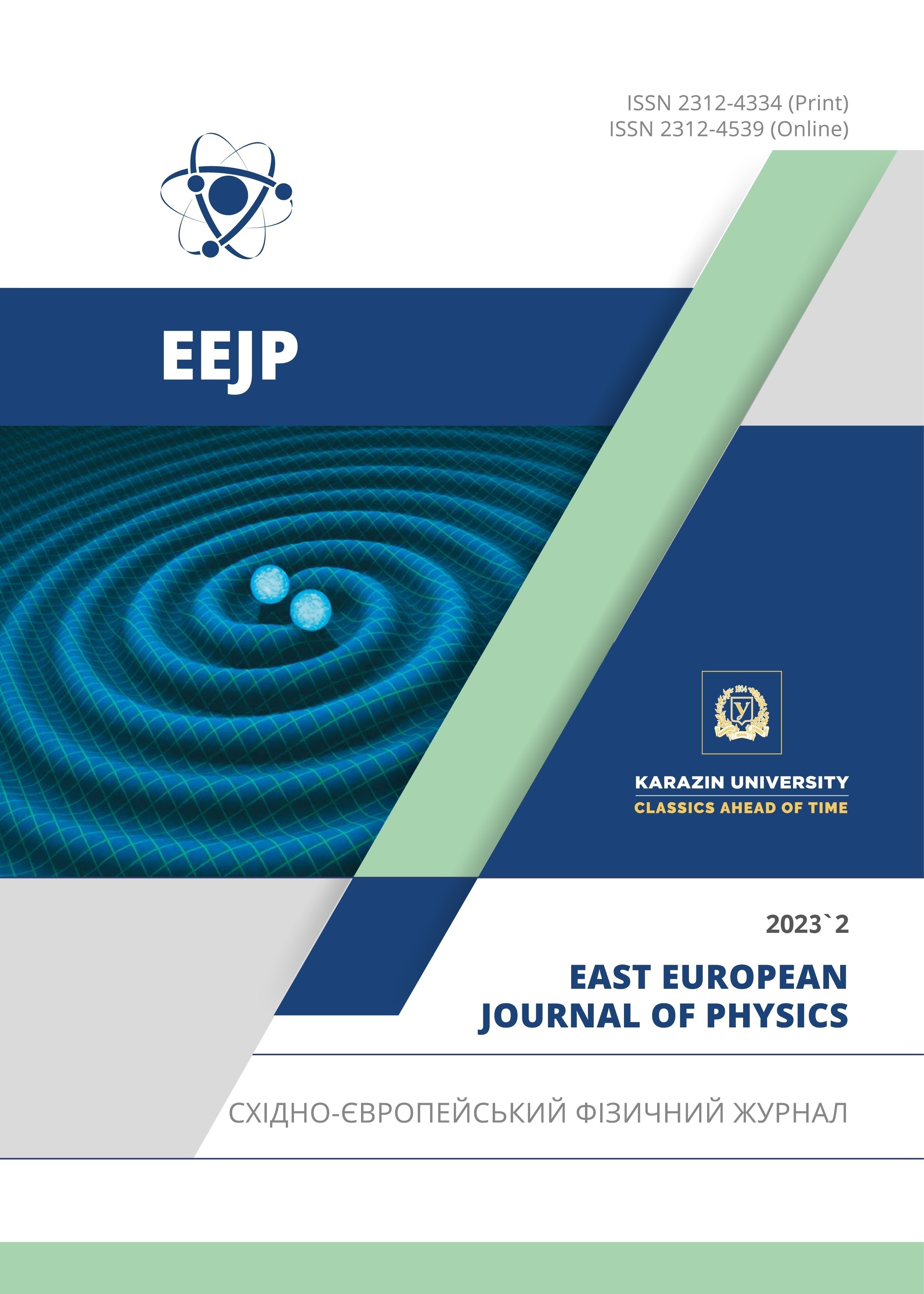Коливальна фероконвекція у пористому середовищі в’язкопружної магнітної рідини з некласичною теплопровідністю
Анотація
Використано класичний аналіз стабільності для вивчення комбінованого впливу в’язкопружності та другого звуку на початок фероконвекції у пористому середовищі. Вважається, що рідина і тверда матриця знаходяться в локальній тепловій рівновазі. Враховуючи граничні умови, відповідні для аналітичного підходу, критичні значення, що стосуються як стаціонарної, так і коливальної нестабільності, отримані за допомогою аналізу нормального режиму. Помічено, що коливальний режим нестабільності є кращим перед стаціонарним режимом нестабільності. Показано, що фероконвекція коливального пористого середовища розвивається через магнітні сили, нелінійність намагніченості, релаксацію напружень за рахунок в’язкопружності та другий звук. З іншого боку, спостерігається, що наявність затримки деформації та пористого середовища затримує початок осцилюючої фероконвекції у пористому середовищі. Також окреслено подвійну природу числа Прандтля на число Релея по відношенню до числа Каттанео. Також обговорюється вплив різних параметрів на розмір конвекційної комірки та частоту коливань. Ця проблема може мати можливі наслідки для технологічних застосувань, у яких використовуються в’язкопружні магнітні рідини.
Завантаження
Посилання
R. Kaiser, and G. Miskolczy, “Some applications of ferrofluid magnetic colloids,” IEEE Transactions on Magnetics, 6, 694-698 (1970). https://doi.org/10.1109/TMAG.1970.1066834
K. Raj, and A.F. Chorney, “Ferrofluid technology-an overview,” Indian J Eng Mater Sci. 5(6), 372‐389 (1998). http://nopr.niscpr.res.in/bitstream/123456789/29661/1/IJEMS%205%286%29%20372-389.pdf
C. Scherer, and A.M.F. Neto, “Ferrofluids: properties and applications,” Braz. J. Phys. 35(3), 718‐727 (2005). https://doi.org/10.1590/S0103-97332005000400018
H.W. Muller, and L. Mario, Ferrofluid Dynamics, in: Ferrofluids magnetically controllable fluids and their applications, edited by S. Odenbach, (Springer, 2002), pp.112-123, https://link.springer.com/book/10.1007/3-540-45646-5
R. Moskowitz, “Dynamic Sealing with Magnetic Fluids,” Tribology Transactions, 18, 135-143 (1975). https://doi.org/10.1080/05698197508982756
Y. Morimoto, M. Akimoto, and Y. Yotsumoto, “Dispersion State of Protein-stabilized Magnetic Emulsions,” Chemical and Pharmaceutical Bulletin, 30, 3024-3027 (1982). https://doi.org/10.1248/CPB.30.3024
R.E. Rosensweig, Ferrohydrodynamics, (Cambridge University Press, Cambridge, 1985).
B.A. Finlayson, “Convective instability of ferromagnetic fluids,” J. Fluid Mech. 40, 753-767, (1970). https://doi.org/10.1017/S0022112070000423
D.P. Lalas, and S. Carmi, “Thermoconvective stability of ferrofluids,” Phys. Fluids, 14(2), 436-437 (1971). https://doi.org/10.1063/1.1693446
Nisha Mary Thomas, and S. Maruthamanikandan, “Gravity modulation effect on ferromagnetic convection in a Darcy-Brinkman layer of porous medium,” J. Phys.: Conf. Series, 1139, 012022 (2018). https://doi.org/10.1088/1742-6596/1139/1/012022
Soya Mathew, and S. Maruthamanikandan, “Darcy-Brinkman ferroconvection with temperature dependent viscosity,” J. Phys.: Conf. Series, 1139, 012023, (2018). http://dx.doi.org/10.1088/1742-6596/1139/1/012023
S. Maruthamanikandan, Nisha Mary Thomas, and Soya Mathew, “Thermorheological and magnetorheological effects on Marangoni-ferroconvection with internal heat generation,” J. Phys.: Conf. Series, 1139, 012024, (2018). https://doi.org/10.1088/1742-6596%2F1139%2F1%2F012024
V. Vidya Shree, C. Rudresha, C. Balaji, and S. Maruthamanikandan, “Effect of MFD viscosity on ferroconvection in a fluid saturated porous medium with variable gravity,” Journal of Mines, Metals and Fuels, 70(3A), 98-103, (2022). http://dx.doi.org/10.26565/2312-4334-2022-4-10
R.B. Bird, C. Armstrong, and O. Massager, Dynamics of Polymeric Liquids, vol. 1,2, 2nd edn. (Wiley, New York, 1987). https://doi.org/10.1002/bbpc.19870911221
D.D. Joseph, Fluid Dynamics of Viscoelastic Liquids, (Springer, New York), (1990), https://doi.org/10.1007/978-1-4612-4462-2
J.G. Oldroyd, “On the formulation of rheological equations of state,” Proc. R. Soc. Lond. A, 200, 523–541 (1950). https://doi.org/10.1098/rspa.1950.0035
T. Green, “Oscillating convection in an elasticoviscous liquid,” Phys. Fluids, 11, 1410-1412 (1968). https://doi.org/10.1063/1.1692123
M.S. Swamy, N.B. Naduvinamani, and W. Sidram, “Onset of Darcy–Brinkman convection in a binary viscoelastic fluid saturated porous layer,” Transp. Porous Med. 94(1), 339–357 (2012). https://doi.org/10.1007/s11242-012-0008-y
D.S. Chandrasekharaiah, “Thermoelasticity with Second Sound: A Review,” Applied Mechanics Reviews, 39, 355-376 (1986). https://doi.org/10.1115/1.3143705
M.E. Gurtin, and A.C. Pipkin, “A general theory of heat conduction with finite wave speeds,” Arch. Ration. Mech. Anal. 31(2), 113-126 (1968). https://doi.org/10.1007/BF00281373
B. Straughan, and F. Franchi, “Bѐnard convection and the cattaneo law of heat conduction,” Proc. R. Soc. Edinburgh Sect. A Math. 96(1-2), 175-178 (1984). https://doi.org/10.1017/S0308210500020564
Soya Mathew, and S. Maruthamanikandan, “Oscillatory porous medium ferroconvection with Maxwell-Cattaneo law of heat conduction,” J. Phys. Conf. Ser. (1), 012024, (2021). https://doi.org/10.1088/1742-6596/1850/1/012024
Soya Mathew, S. Maruthamanikandan, and S.S. Nagouda, “Gravitaional Instability in a Ferromagnetic Fluid Saturated Porous Medium with Non-Classical Heat Conduction,” IOSR Journal of Mathematics, (IOSR-JM), 6(1), 07-18 (2013). http://dx.doi.org/10.9790/5728-0610718
B. Straughan, “Oscillatory convection and the Cattaneo law of heat conduction,” Ricerche mat. 58, 157-162 (2009). https://doi.org/10.1007/s11587-009-0055-z
S.S. Nagouda, and S. Pranesh, “Rayleigh-Bѐnard convection in a second-order fluid with Maxwell-Cattaneo Law,” The Bulletin of Society for Mathematical Services and Standards, 2, 24-32 (2012). https://doi.org/10.18052/WWW.SCIPRESS.COM%2FBSMASS.2.24
Авторське право (c) 2023 Насір Ахмед, С. Марутаманікандан, Б.Р. Нагасміта

Цю роботу ліцензовано за Міжнародня ліцензія Creative Commons Attribution 4.0.
Автори, які публікуються у цьому журналі, погоджуються з наступними умовами:
- Автори залишають за собою право на авторство своєї роботи та передають журналу право першої публікації цієї роботи на умовах ліцензії Creative Commons Attribution License, котра дозволяє іншим особам вільно розповсюджувати опубліковану роботу з обов'язковим посиланням на авторів оригінальної роботи та першу публікацію роботи у цьому журналі.
- Автори мають право укладати самостійні додаткові угоди щодо неексклюзивного розповсюдження роботи у тому вигляді, в якому вона була опублікована цим журналом (наприклад, розміщувати роботу в електронному сховищі установи або публікувати у складі монографії), за умови збереження посилання на першу публікацію роботи у цьому журналі.
- Політика журналу дозволяє і заохочує розміщення авторами в мережі Інтернет (наприклад, у сховищах установ або на особистих веб-сайтах) рукопису роботи, як до подання цього рукопису до редакції, так і під час його редакційного опрацювання, оскільки це сприяє виникненню продуктивної наукової дискусії та позитивно позначається на оперативності та динаміці цитування опублікованої роботи (див. The Effect of Open Access).








